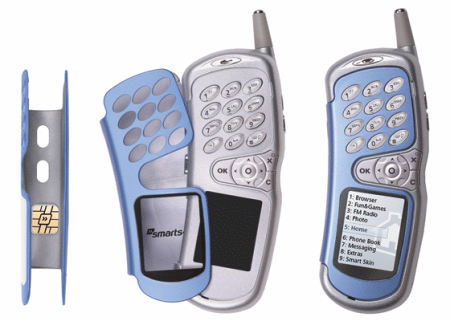Article: Sneak preview: a Linux powered wireless phone
Oct 9, 2001 — by Rick Lehrbaum — from the LinuxDevices Archive — 2 viewsWildseed Ltd. (formerly GITWiT) is currently developing a Linux-based wireless handset which combines communications and entertainment within a uniquely customizable two-part design. The Kirkland, WA based company plans to initially aim the device at the lucrative teen market, by offering a colorful phone with cool teen-oriented capabilities.
According to Wildseed's market research, roughly 25% of the 40 million teens in the U.S. own wireless phones today, leaving 30 million potential additional subscribers up for grabs.
The how and why of a two-part phone design
Physically, the Wildseed phone consists of two pieces (see photo, below). The Wildseed handset contains the core telephony functionality. A software-enabled cover, called a Smart Skin, snaps onto the handset core to define a specific and easily alterable look, feel, and wireless user experience.

Each Smart Skin contains a Smart Key, which is built around an industry standard secure smart card module. Smart Keys contain encrypted data and software that changes the wireless user experience to match the theme of the skin.
As an example, users snapping on skins branded by their favorite music group might get a new look and feel for the user interface, plus customized ring tones and graphics, preconfigured wireless web bookmarks, and subscription content for the group's latest CDs and upcoming concerts.
Wildseed expects its innovative approach to be popular with wireless carriers because it permits them to rapidly embrace changing fashion and entertainment trends by refreshing the relatively expensive core cellular component with an inexpensive snap-on Smart Skin.
Under the hood
From a technical perspective, Smart Skin enabled handsets are composed of three main parts: a cellular processor, a proprietary Smart Key operating system, and an embedded host processor.
The host processor, an embedded computer running Linux, is the heart of the phone. It is built around an XScale microprocessor and contains a number of embedded peripherals and I/O interfaces for the keypad, color LCD, and for communicating with the Smart Skins.
A separate cellular processor handles all of the on-air cellular communications.
Wildseed uses the 2.4.5 Linux kernel with ARM patches from Russell King and Nicolas Pitre, as well as a number of in-house patches. The system software also includes BusyBox.
Why Linux?
“We chose Linux for a number of reasons”, explains Wildseed VP of Engineering Peter Zatloukal. “We are building a user interface that is leagues beyond what exists on current wireless phones, and Linux provides us with a rich environment with which to render our ideas.”
“Also, since most of our development work is in the application and object layers, we're glad to be using an Open Source kernel so that we can contribute to efforts that make it easier for others to develop embedded solutions,” adds Zatloukal.
“We feel that increasing the ease of innovation in the embedded space, even if it also strengthens our competitors, helps us because it broadens the whole market. We like the world where low barriers to entry fuel competition around what really matters — a richer wireless user experience.”
.
This article was originally published on LinuxDevices.com and has been donated to the open source community by QuinStreet Inc. Please visit LinuxToday.com for up-to-date news and articles about Linux and open source.